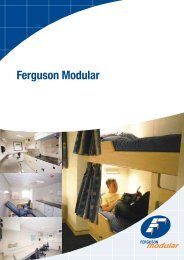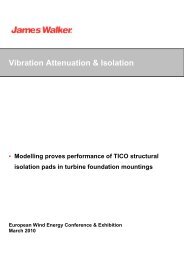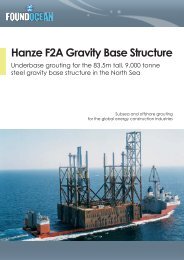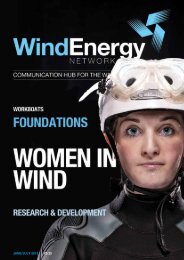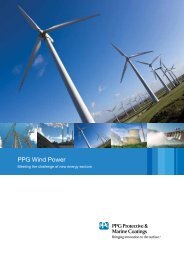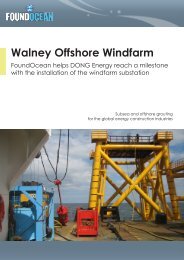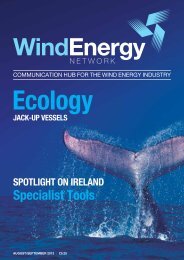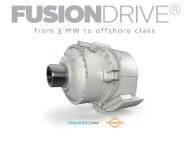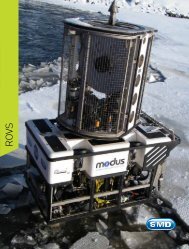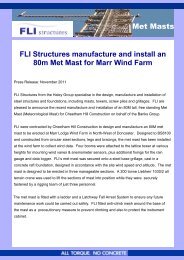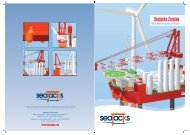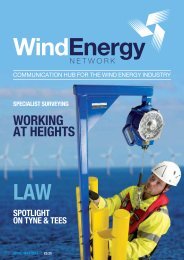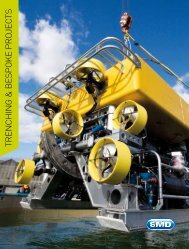UNEXPLODED ORDNANCE - Wind Energy Network
UNEXPLODED ORDNANCE - Wind Energy Network
UNEXPLODED ORDNANCE - Wind Energy Network
You also want an ePaper? Increase the reach of your titles
YUMPU automatically turns print PDFs into web optimized ePapers that Google loves.
SPONSORS OF EAST OF SCOTLAND<br />
Technip Offshore <strong>Wind</strong> pioneers vital step<br />
change in safety for cable installation<br />
A ground-breaking new technology<br />
which significantly reduces offshore<br />
array cable pull-in time by up to 60%<br />
and offers a vital step-change in<br />
safety practices has been pioneered<br />
by Technip Offshore <strong>Wind</strong>.<br />
Pull-In Module (PIM) – reduces<br />
time and risk<br />
The integrated Pull-In Module reduces<br />
the risk of injury to personnel offshore and<br />
saves substantial operational time at each<br />
cable end with the innovation having been<br />
successfully launched and recovered more<br />
than 30 times without incident.<br />
Identifying existing operational<br />
pitfalls<br />
Technip developed the PIM after<br />
identifying pitfalls in existing methods<br />
of conventional lifting equipment used<br />
to install cables subsea and through<br />
J-tubes.<br />
The safety challenges included: wires<br />
strained under tension on deck; the winch<br />
operator being remote from the work<br />
site; and the frame considered unsafe for<br />
personnel working at height.<br />
The operational inefficiencies identified<br />
by Technip were: the frame was liable<br />
to swing around on the crane while also<br />
not being aligned or bolted down; the<br />
movement of a vessel was able to snap<br />
winch wires and a lengthy three hours<br />
preparatory work was necessary before<br />
installing cables.<br />
Ron Cookson, Senior Vice President<br />
at Technip Offshore <strong>Wind</strong>, said: “The<br />
challenges identified meant personnel<br />
were exposed to risk of injury while<br />
the cable pull-in operations required<br />
significant, costly vessel time. These<br />
difficulties can also be further exacerbated<br />
by environmental factors such as poor<br />
subsea visibility and strong currents.<br />
“When developing PIM, we aimed reduce<br />
the safety risks by removing vessel winch<br />
wires from operation and introducing<br />
compliance to industry standards. We<br />
also wanted to improve operations by<br />
reducing vessel dependency time as well<br />
as making the array cable installation<br />
process smoother and safer.<br />
“As a result of its design, PIM has<br />
substantially improved safety during<br />
key operational phases and increased<br />
operational efficiency.”<br />
Specifications<br />
PIM is a three-leg tripod featuring a selfcontained<br />
winch, equipment storage, and<br />
no bolted connections. It can be installed<br />
in any orientation and reduces damage<br />
risk to transition pieces.<br />
As a result, it not only removes vessel<br />
winch wires from operation and is<br />
compliant to industry standards, but it<br />
fundamentally reduces vessel<br />
dependency and improves the<br />
speed of installation. It also<br />
provides on-board equipment<br />
storage and incorporates power<br />
supply for lighting and tools.<br />
Ron Cookson added: “Ultimately, PIM<br />
provides personnel with significantly<br />
safer work platforms for cable pull-in<br />
activities, while pull-in completion time<br />
is radically reduced by up to 60%. This<br />
is a major game changer for the industry<br />
and underpins Technip Offshore <strong>Wind</strong>’s<br />
market-leading position in offshore and<br />
infrastructure project management and<br />
its commitment to helping clients deliver<br />
projects cost-effectively, safely and on<br />
schedule.”<br />
Technip Offshore <strong>Wind</strong><br />
www.technip.com<br />
76<br />
www.windenergynetwork.co.uk



